Travel
How to Tour The Vatican: A Complete Guide To Visiting the Vatican
As the smallest country in the world, and known for its religious history and artwork, The Vatican is a destination that enchants any visitor.
Nestled within the heart of Rome, the Vatican City is not just a mere tourist spot; it’s a spiritual and cultural treasure trove that’s abounding in wonders waiting to be explored.
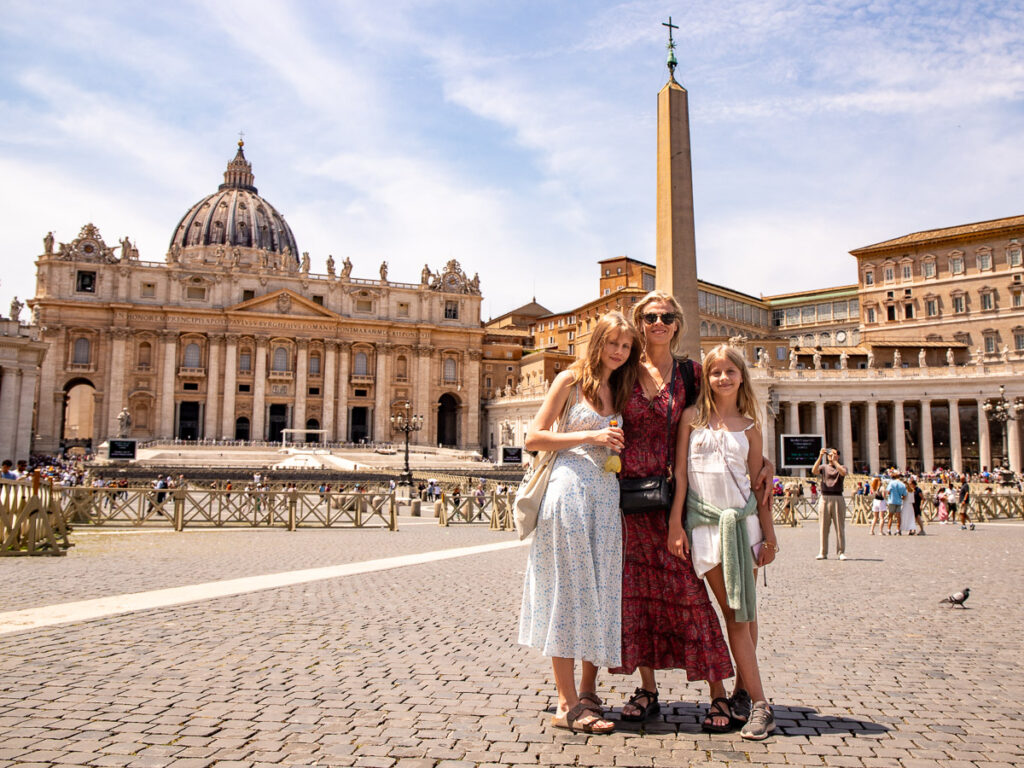
In this guide, we delve into the rich history, unmissable attractions, and important tips for visiting, so you can visit Vatican City without a hitch.
Whether you’re visiting The Vatican to marvel at the enormity of St. Peter’s Basilica, wander through centuries-old galleries adorned with masterpieces by renowned artists in The Vatican Museum, or stand in awe before the iconic Sistine Chapel, this guide will tell you how to tour The Vatican in the best way.
Our Small Group Tour of the Vatican
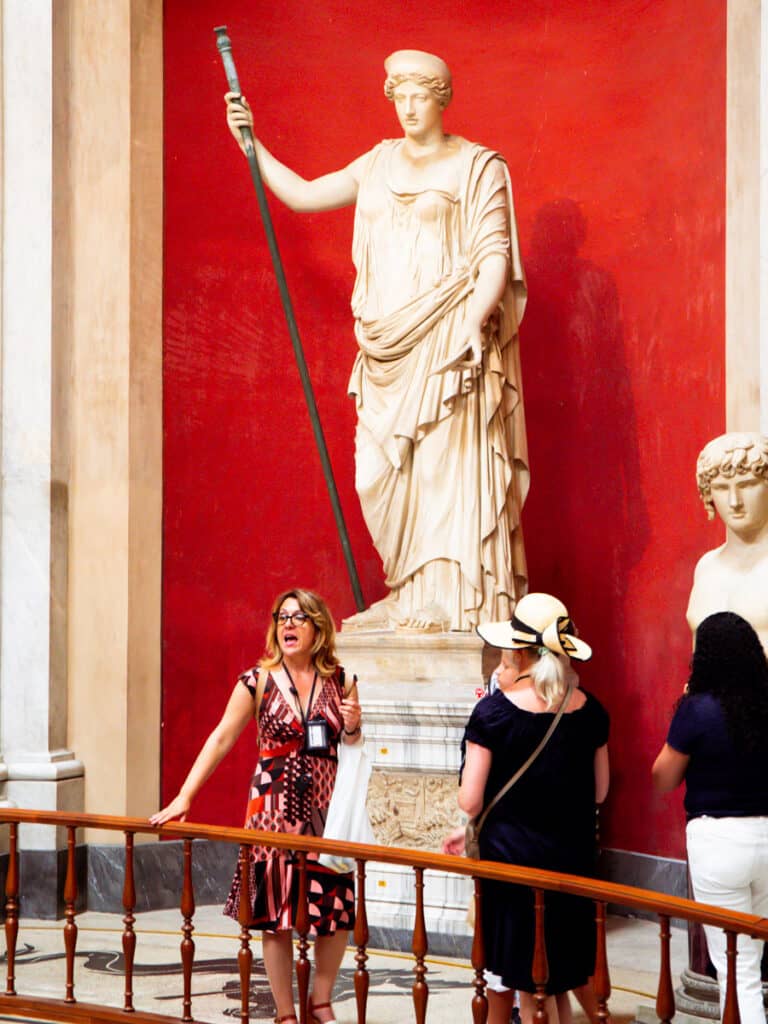
Before we dive into the history of the Vatican and the various things to see and do once inside, I want to share our experience, and what I think is the best tip for visiting the Vatican.
It’s important to understand the best way to see the Vatican, as it can be the difference between the worst experience ever to something valuable.
We learned this the hard way, by the making wrong decision when it came to visiting the Colosseum. We did it on our own, got swept up in the crazy crowds missed half of it and gained no insights into its importance or architectural magnificence.

In contrast, we visited the Vatican – equally intense with the crowds – on a small-group guided tour with Liv Tours and enjoyable the experience learning a lot about its historical significance along the way.
Our guide, Kathy (an art historian) was excellent at steering us around the crowd, showing us the most essential pieces of art and the Vatican so we didn’t miss it, and gave us a lot of insights into the Vatican, Sistine Chapel, and St Peter’s Basilica. I never would have understood the meaning behind the Sistine Chapel frescos without her and it made it even more awe-inspiring to me.
There’s only a max of six people on the tour, which is also another great benefit. It’s easier to navigate into tight spaces to get up close to artifacts. Kathy was taking no prisoners and proudly let us know we could drop our politeness and be direct Europeans.
This tour also includes skip the line benefits into the Vatican.
The History of The Vatican

The Vatican’s history is a long and captivating tale that dates back centuries. Its origins can be traced to ancient Rome, where a small hill on the banks of the Tiber River served as the residence of the popes after the fall of the Roman Empire.
However, it wasn’t until the 4th century AD that the construction of a basilica over the grave of St. Peter marked the beginning of the Vatican’s significance as the seat of the Catholic Church.
Kathy told us a lot about the events surrounding St Peter’s upside-down crucifixion and how this became the place for the Vatican, for as instructed to Peter, “On this rock I build my church.” This is why you always see Peter holding keys – showing that he is the head of the Chruch. Kathy pointed this out in every representation we saw of him on the Vatican tour.
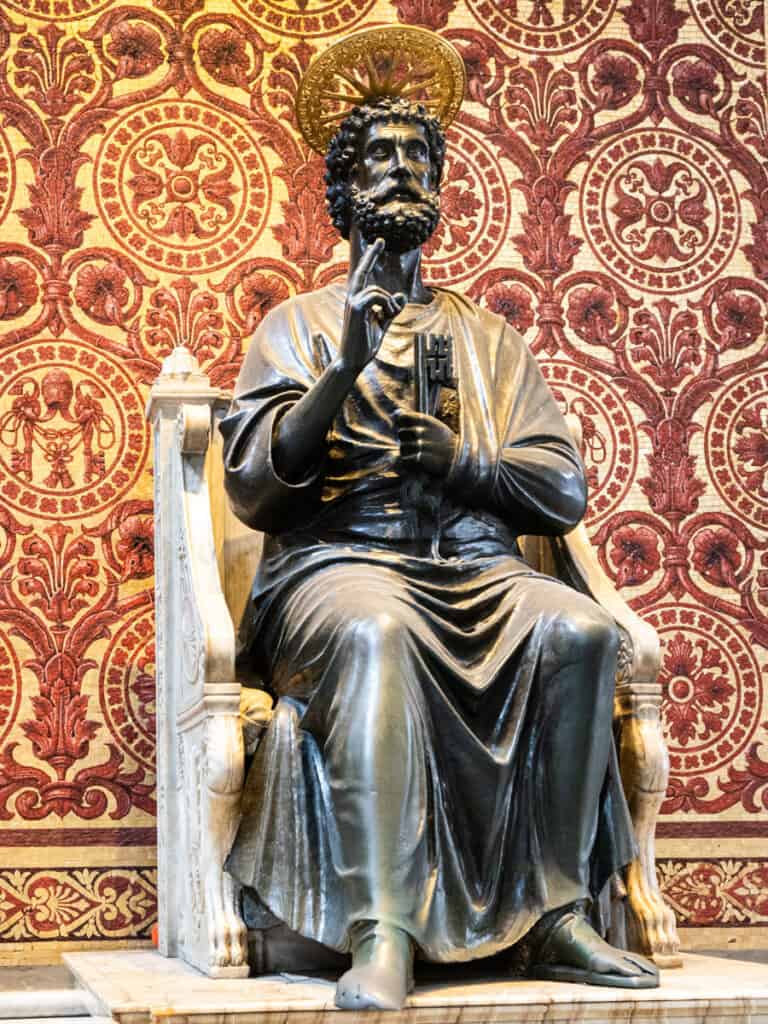
Over the years, the Vatican’s influence grew, and it gained control of territories surrounding Rome, becoming the capital of the Papal States. This period lasted from the 4th century to 1870.
In 1929, the independent state of Vatican City was established through the Lateran Treaty between the Holy See and Italy.
Vatican City became the spiritual and administrative center of the Catholic Church, and is most famous for being the residence of the Pope.
Today, the Vatican stands as a symbol of faith, history, and art, attracting millions of pilgrims and tourists who yearn to witness the grandeur and spirituality that permeate this sacred enclave.
What is the Best Time to Visit The Vatican?
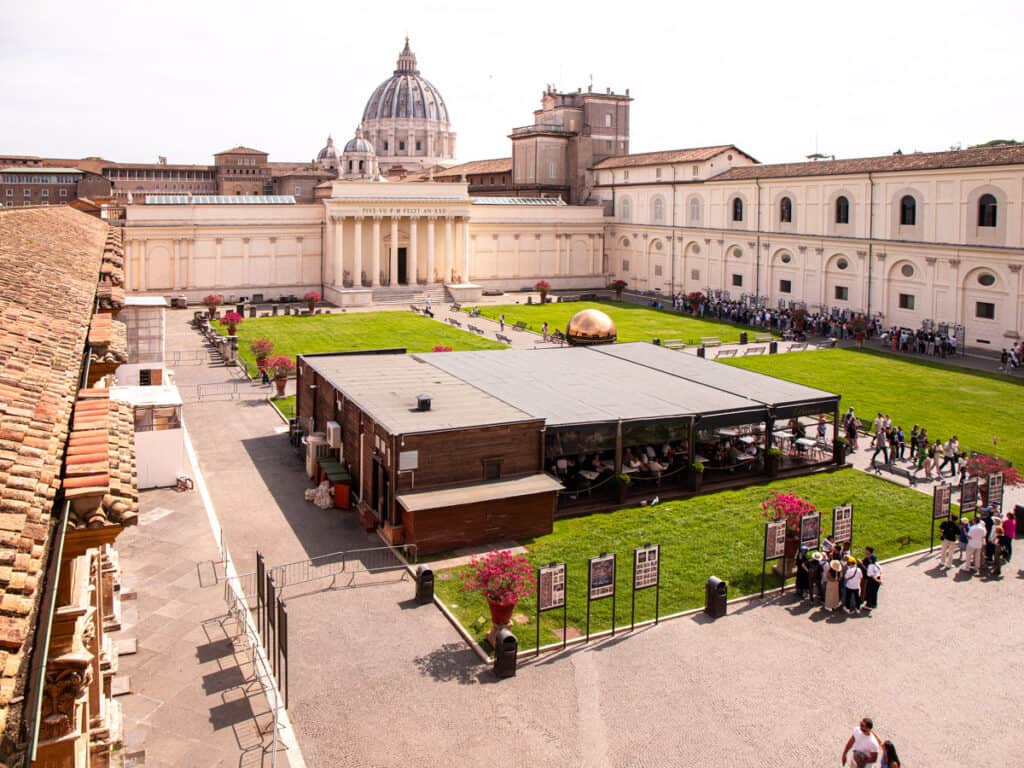
The best time to visit The Vatican is in the months of March and April, when the weather is generally warm and pleasant, and the crowds are relatively sparse compared to peak tourist season (summer).
An insider tip is to take advantage of the 7:30 am VIP entrance ticket, which grants you early access to the museums and the magnificent Sistine Chapel.
This allows you to marvel at the masterpieces in a more serene atmosphere before the crowds accumulate.

However, if you don’t like getting up early, be aware that no matter what day of the week it is, by 9.00 am The Vatican will be swarming with people. The crowds usually won’t disperse until after the sun sets.
This is why we always recommend purchasing skip-the-line tickets beforehand as there is no real quiet period in The Vatican. We were on the 2:30pm afternoon tour. Our guide said her 10am tour was even busier!
You can also visit beat the crowds on this special Vatican by night tour, which includes a visit to a Secret Room! Be sure to come back and tell me what that is!
What Is There To See In The Vatican?
Although being the smallest country in the world, there is plenty to see. Below are some of the top things to do in The Vatican…
The Pinecone Courtyard Dome View
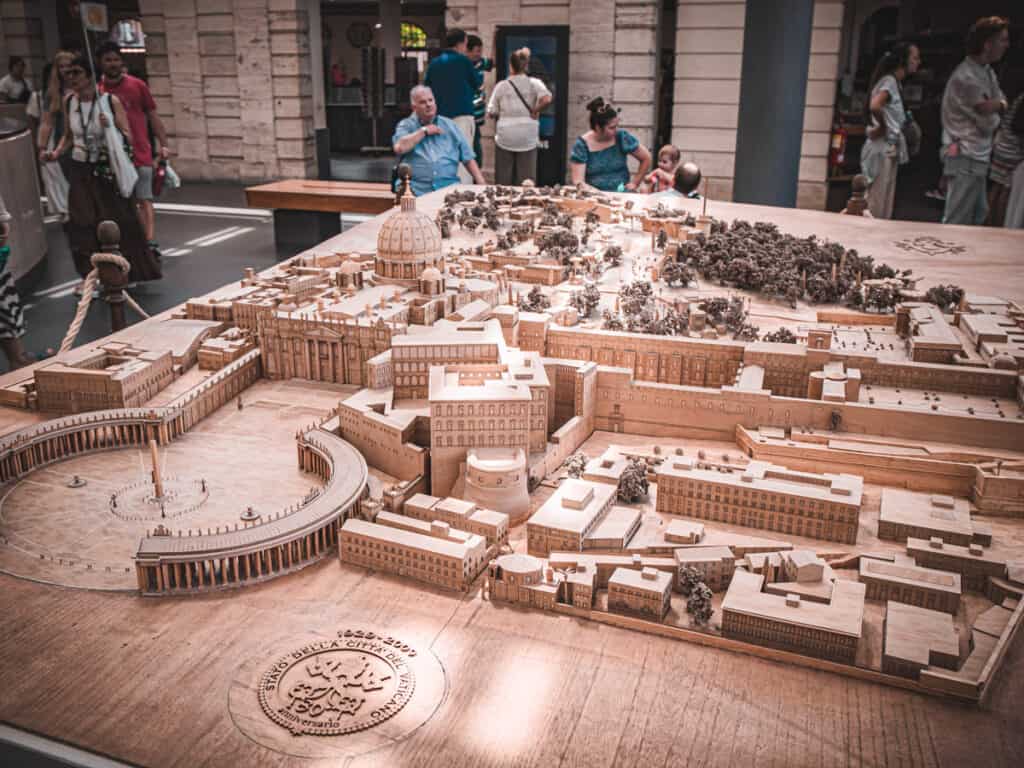
After Kathy steered us past the long line, through security and to collect our headpieces, she took us straight upstairs to a 3D model of the Vatican pointing out where we were and where we were going. It helped to give context to what this small country looks like as visitors can only see a small section.
She then took us outside to see her favorite view of St Peter’s Dome, which is where I grew quite regretful that we were not able to climb it for views over Rome.
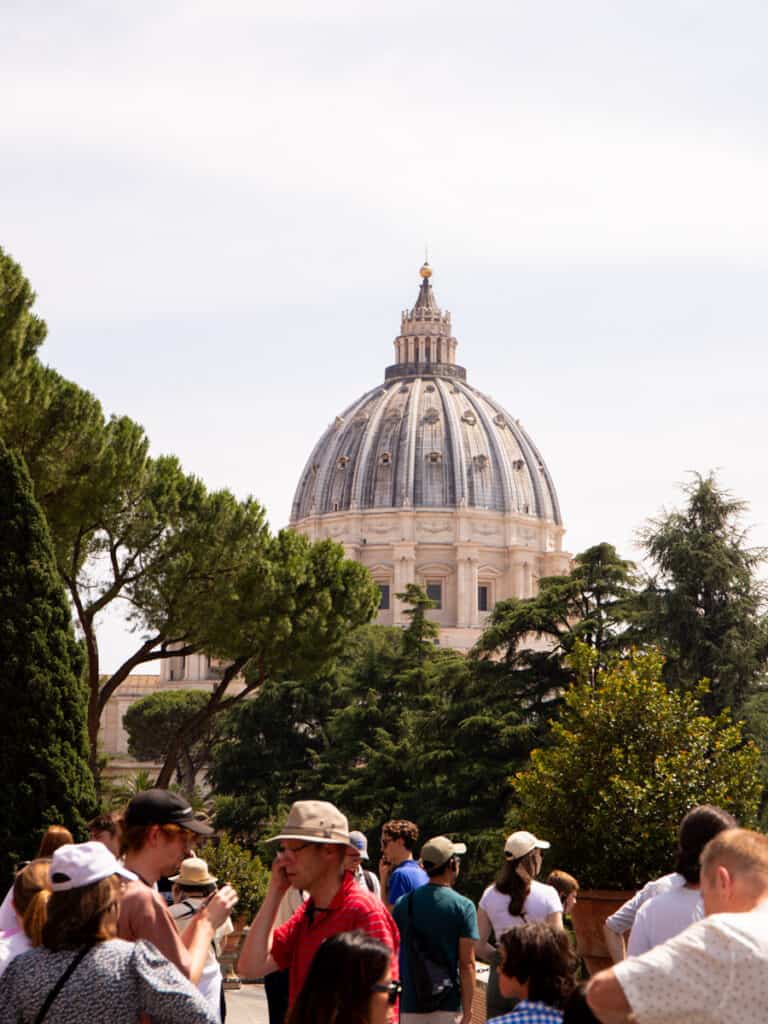
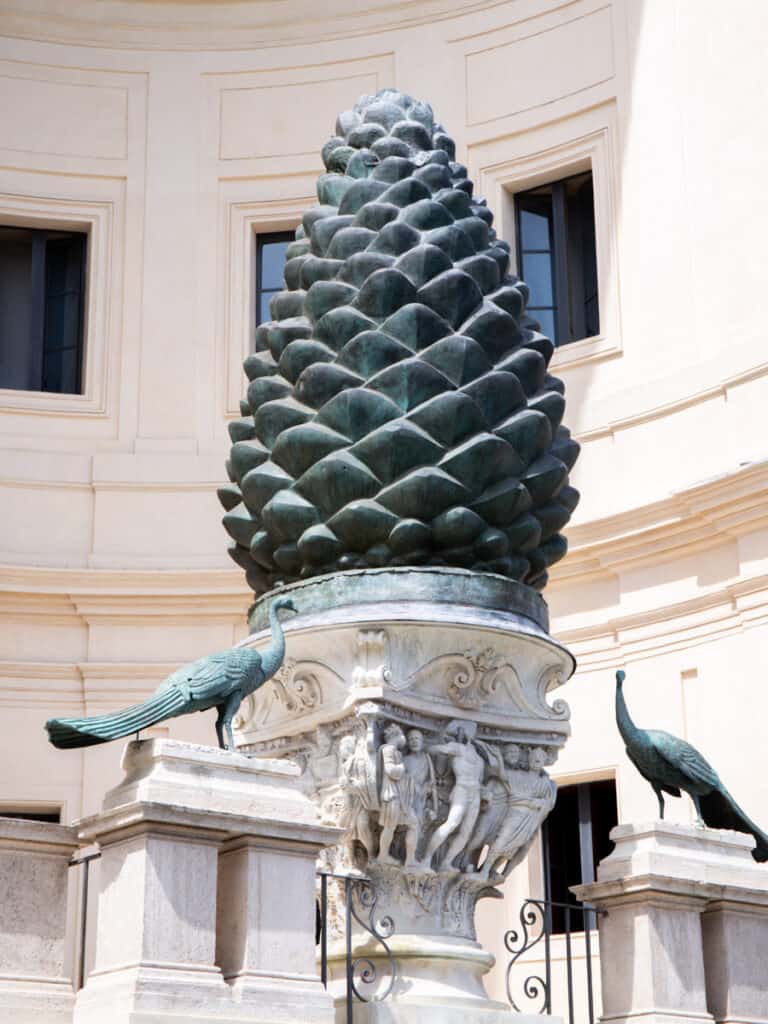
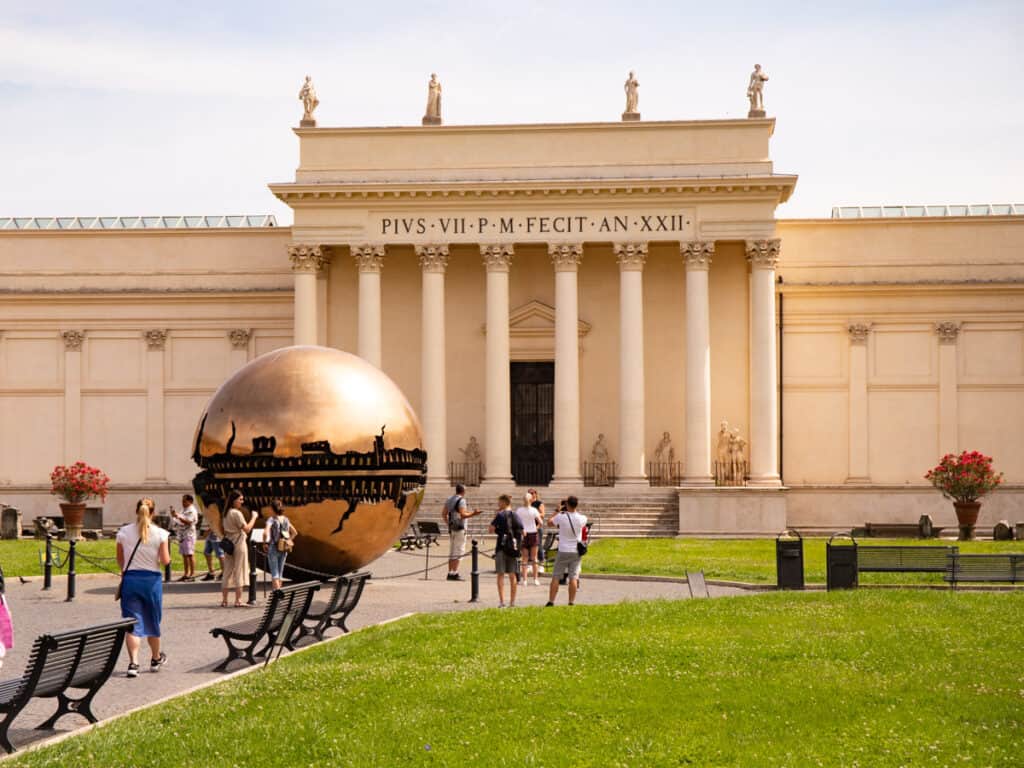
Then we proceeded to the Pinecone courtyard to learn more about the Sistine Chapel. I was grateful we could stand in the shade with Kathy’s iPad, rather than crowd around the information billboards in the hot sun and try to learn about it ourselves.
Now we were ready to go inside the small halls and galleries with thousands of others inside the Vatican Museum.
You can join this early morning tour of the Vatican, which includes breakfast in the Pineyard Courtyard before the crowds come. Many people recommended it to us.
The Vatican Museum
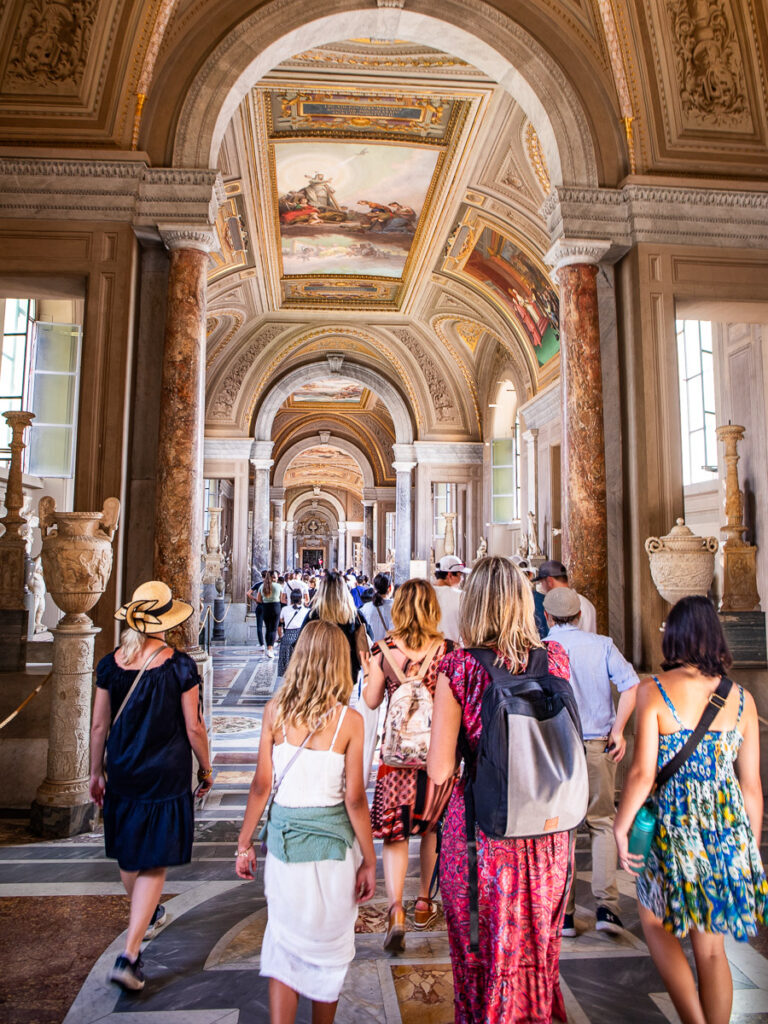
The Vatican Museums and the Sistine Chapel are two of the most popular attractions in Rome and are known for their unparalleled beauty in both architecture and artistic mastery.
The Vatican Museums, comprising a vast collection of art and historical treasures, offer visitors a fascinating journey through time.
From ancient Egyptian artifacts to Renaissance masterpieces, every corner holds captivating wonders. Be sure to check out the Scala Elicoidale Momo, the original spiral staircase from the 16th century, and the Vatican Apostolic Library.
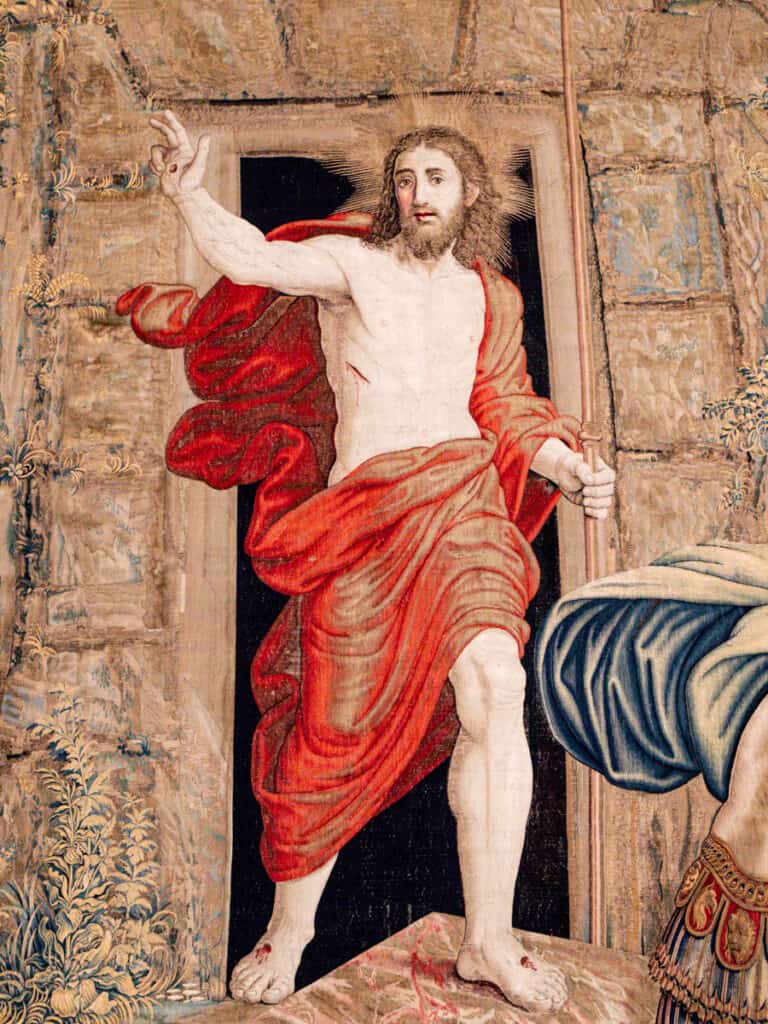

I was quite astounded at this collection as we walked through the halls and Kathy pointed out significant pieces. I knew I was walking past some of the most beautiful and revered pieces of art in the world, some of which have lasted for thousands of years.
Like this magnificent 2000-year-old statue which used to be Nero’s Palace.

She made sure we did not miss the stunning ceilings and the tapestries on the walls, but also the significance of the floor we were walking on.
Made from marble stripped from Palatine Hill, it was thousands of years old with splashes of red marble – the color reserved only for those of the highest order.
I especially loved the intricate mosaic designs in various sections on the floor.

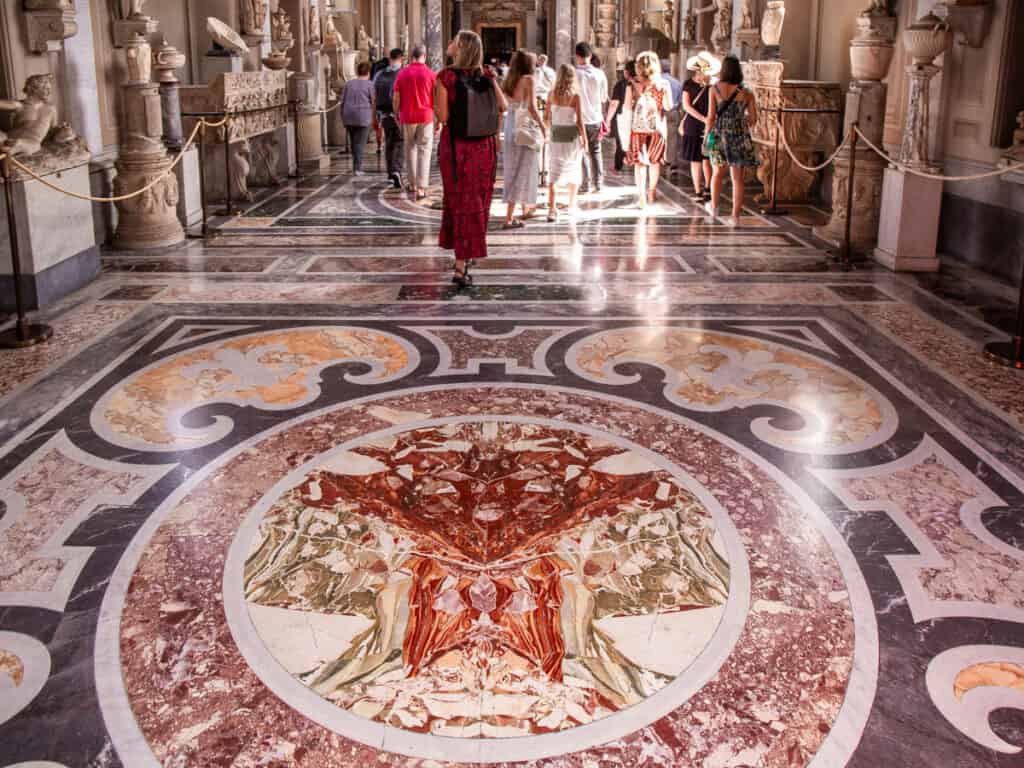

It’s important to know that in the Vatican – well any church or ancient building in Europe – you must always look at the floor and the ceiling. You’ll be stunned by the elaborate designs.
I would have been overwhelmed trying to see all this on my own. It was too hot and too busy; I wouldn’t have been able to read anything to learn the historical significance of what we’re looking at.
I’ve been to the Vatican before, and I don’t even remember walking through this museum! I was probably bored by it as I wasn’t on a tour. This time I was completely in awe. Kathy made all the difference.
The Sistine Chapel
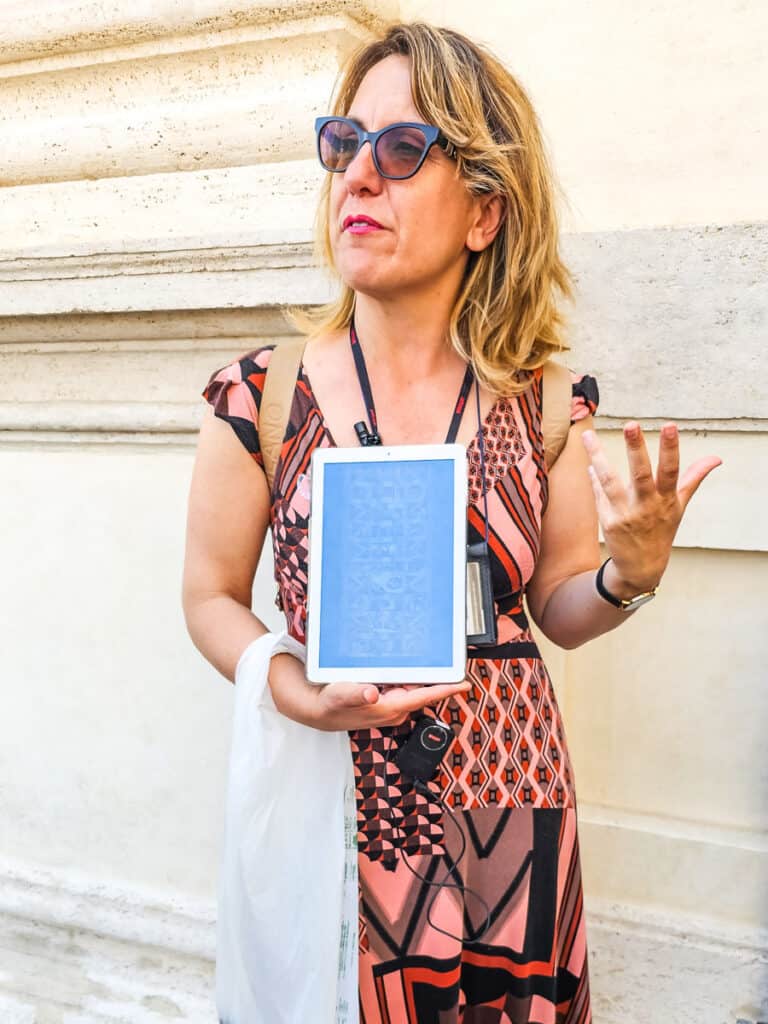
The crown jewel of the Vatican Museums is undoubtedly the Sistine Chapel, renowned for Michelangelo’s awe-inspiring frescoes, including the iconic portrayal of “The Creation of Adam.”
At the beginning of our tour, Kathy stopped us in the beautiful courtyard of the museum to explain the frescoes in the Sistine Chapel. You cannot speak in the Sistine Chapel, so Kathy took out her iPad with images of the artwork and described what they were, how they were made, and the symbolism behind them.
I liked Michaelangelo’s sense of humor putting a clergy main as the evil person, as he had complained about his use of naked figures in the paintings. (Which they clothed once Michelangelo died!)
Stepping into the Sistine Chapel is an experience like no other, as you find yourself surrounded by breathtaking art and immersed in the spiritual ambiance of this sacred space.
Visitors are often left in awe, gazing up at the intricately detailed ceiling and marveling at the profound talent that brought it to life.
You also cannot take photos in the Sistine Chapel. Attendants will jump on the microphone every couple of minutes to remind you.
I loved the Last Judgement Wall even more than the creation story depicted in the ceiling. I spent quite some time absorbing all of it and looking for those features Kathy had pointed out to us earlier.
You cannot enter the Sistine Chapel or St Peter’s Basilica without having your knees and shoulders covered, so wear appropriate clothing or bring a scarf to put across your shoulders.
St Peter’s Basilica
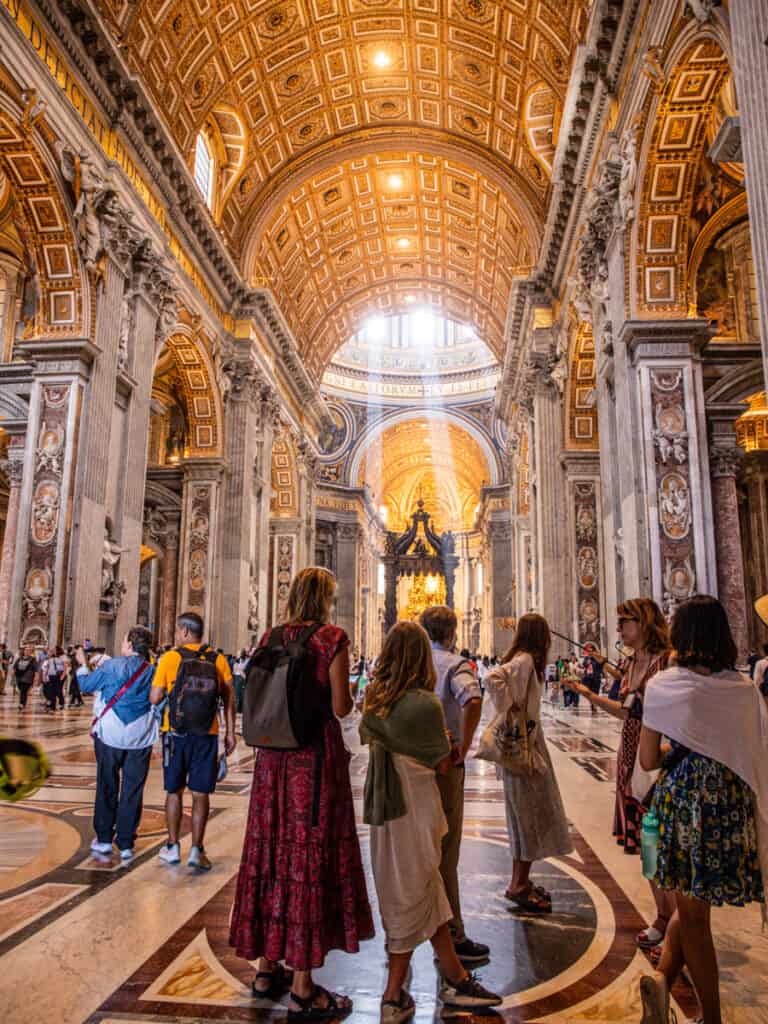
Situated in the heart of Vatican City, St. Peter’s Basilica stands as an architectural masterpiece and a testament to centuries of devotion and artistic brilliance.
Its history dates back to the 4th century when Emperor Constantine ordered the construction of a basilica over the burial place of Saint Peter. The original structure underwent several renovations and expansions over the years but remains one of the most beautiful cathedrals in the world.
Today, St. Peter’s Basilica is not only a symbol of Roman Catholicism, welcoming millions of pilgrims and tourists from around the world, but a home to some of the biggest masterpieces in Renaissance and Baroque artwork.
Mass is held five times a day in the Basilica, and one was happening up the back altar while we wandered around When the Pope holds mass on important Catholic holidays, the church holds up to 60,000 people.
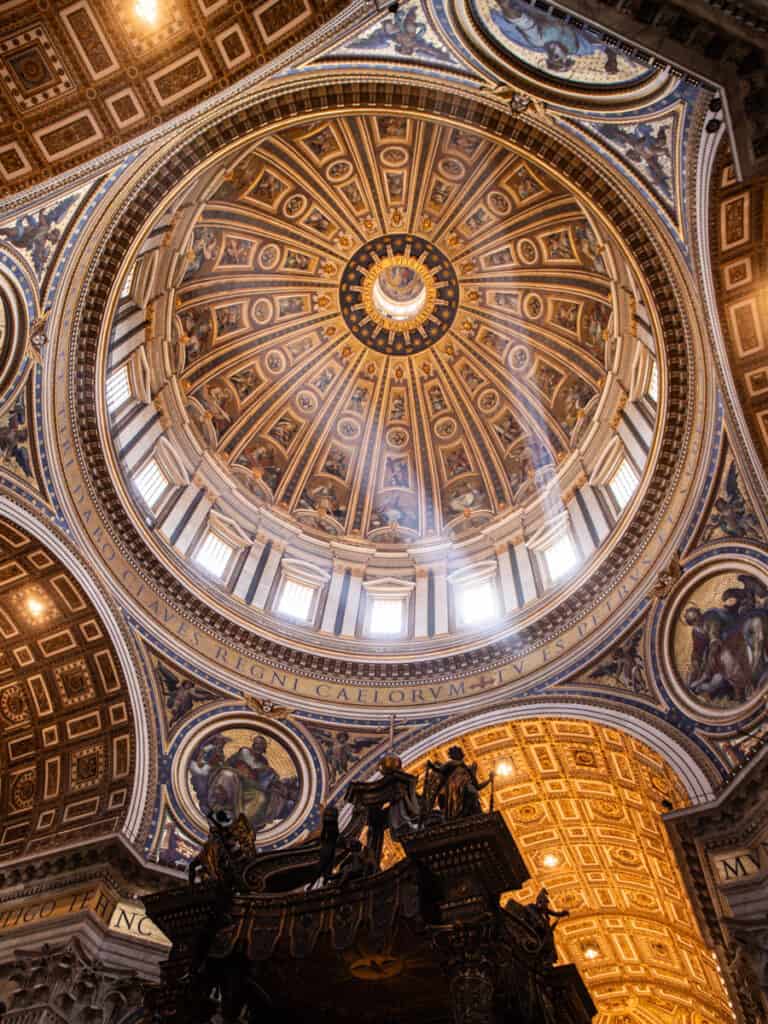
The basilica is home to notable masterpieces, including Michelangelo’s renowned sculpture, the Pietà, and his magnificent dome, which offers panoramic views of Rome.
Some of the things I loved seeing and learning about inside the Basilica include:
Pieta, Michaelangelo carving of Mary holding dead Jesus was behind bullet proof glass thanks to a crazy Australian who damaged the statue. Kathy told us that many people stole fragments of it but after the Pope put it on TV, many returned them out of guilt.

The magnificent altar where the branches of the cross meet over the tomb of Peter.
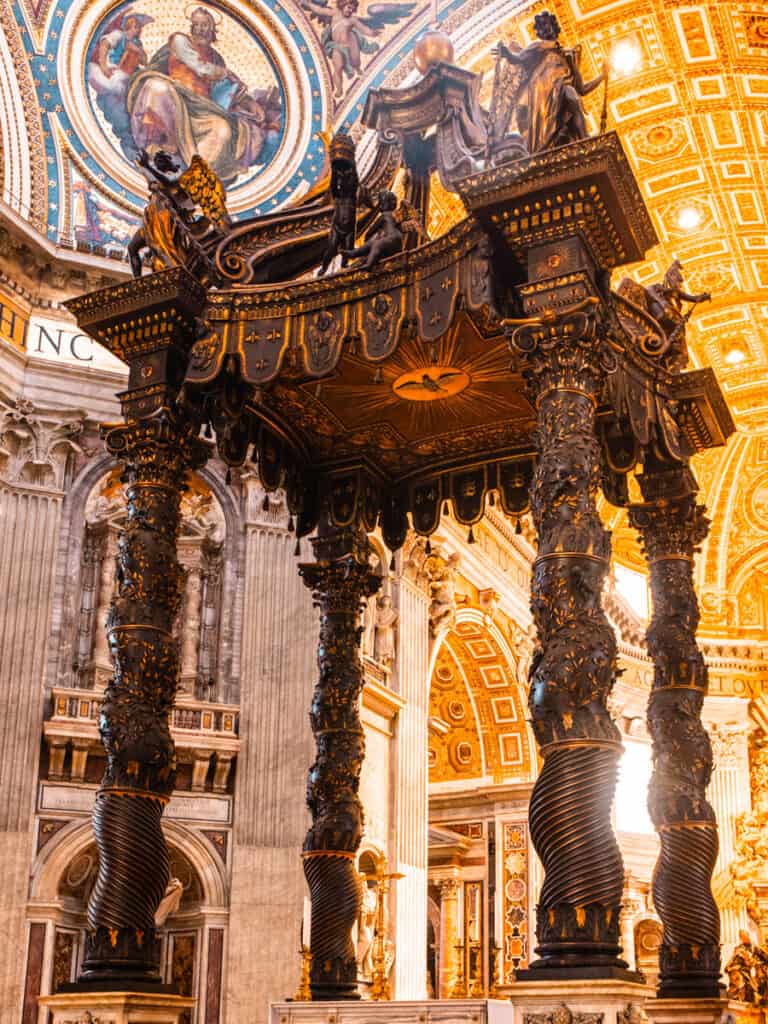
The gold and bronze altar at the back was particularly striking with the bird that looks like a stained-glass window but is actually marble.
It’s designed so that after summer solstice light shines through at 5 pm on main altar and reminder that it faces east like all major religion churches.
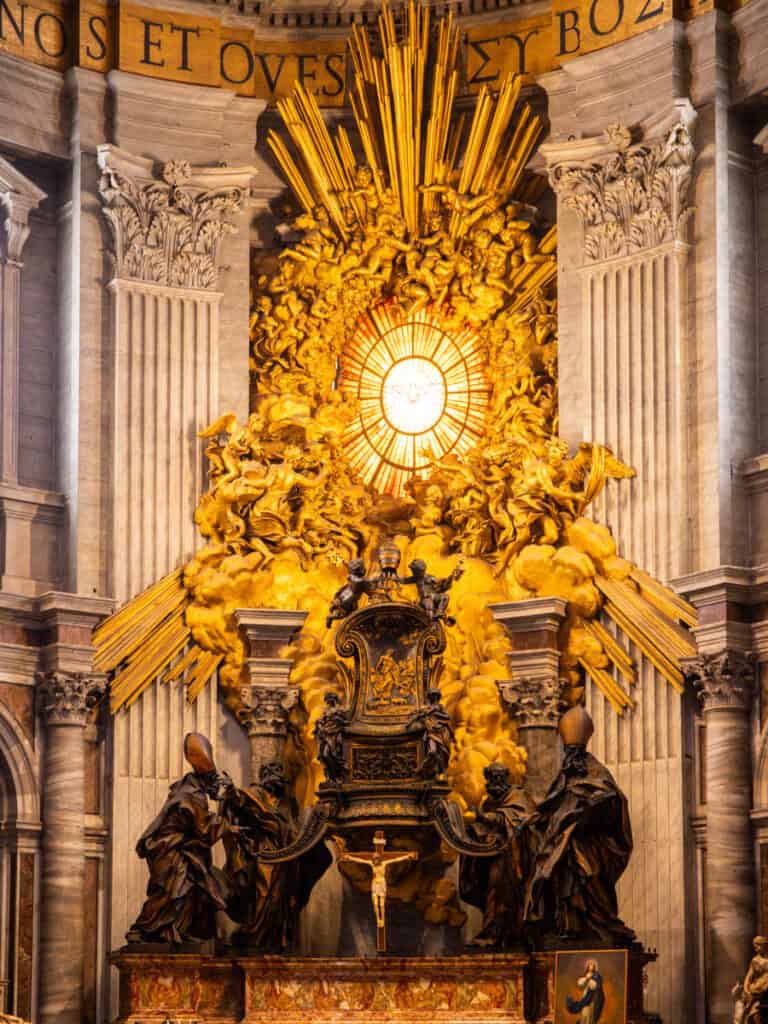
The statues on the niche of the wall show the relics that used to be here. I loved the Veil of Veronica, where she is holding a veil with the face of Jesus etched on it.

Inside the main floor of the basilica though are real mummies of previous popes. I found this fascinating, although a little creepy.
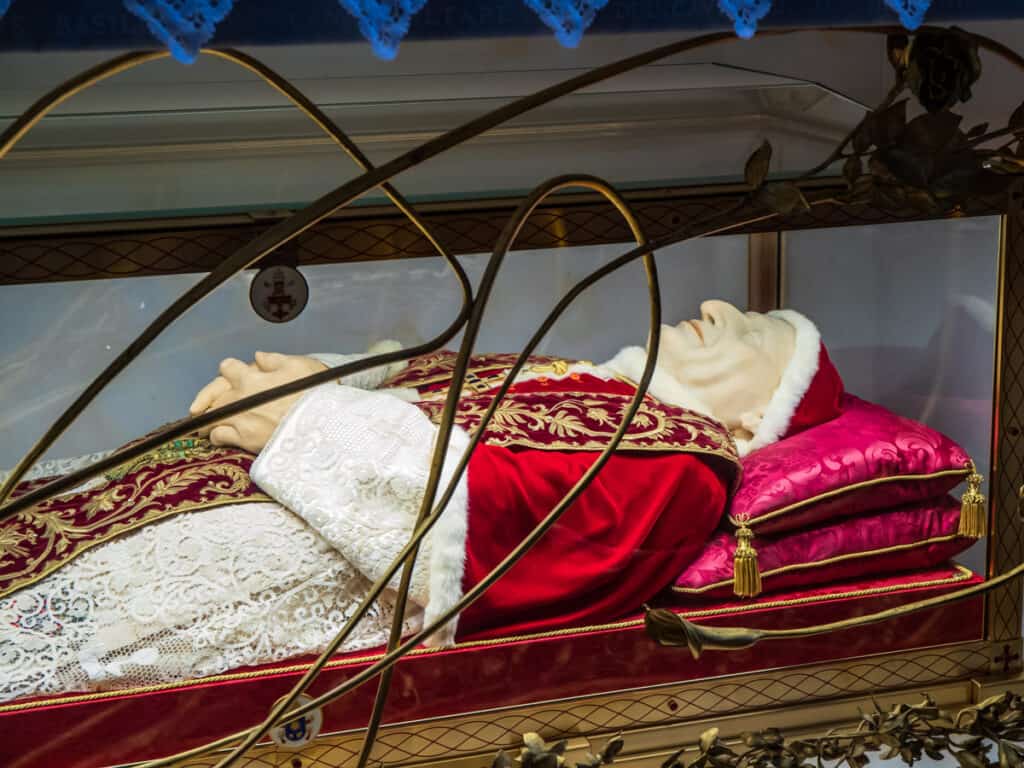
The famous monument of Alexander VII, the last great masterpiece of 80-year-old Bernini.
There was so much symbolism in it, but most intriguing was the skeleton of Death coming out of the curtain expressing the concept that life is temporary, and you’ll die. It’s one of the weirdest things to see, and more fun than the other boring Pope monuments.
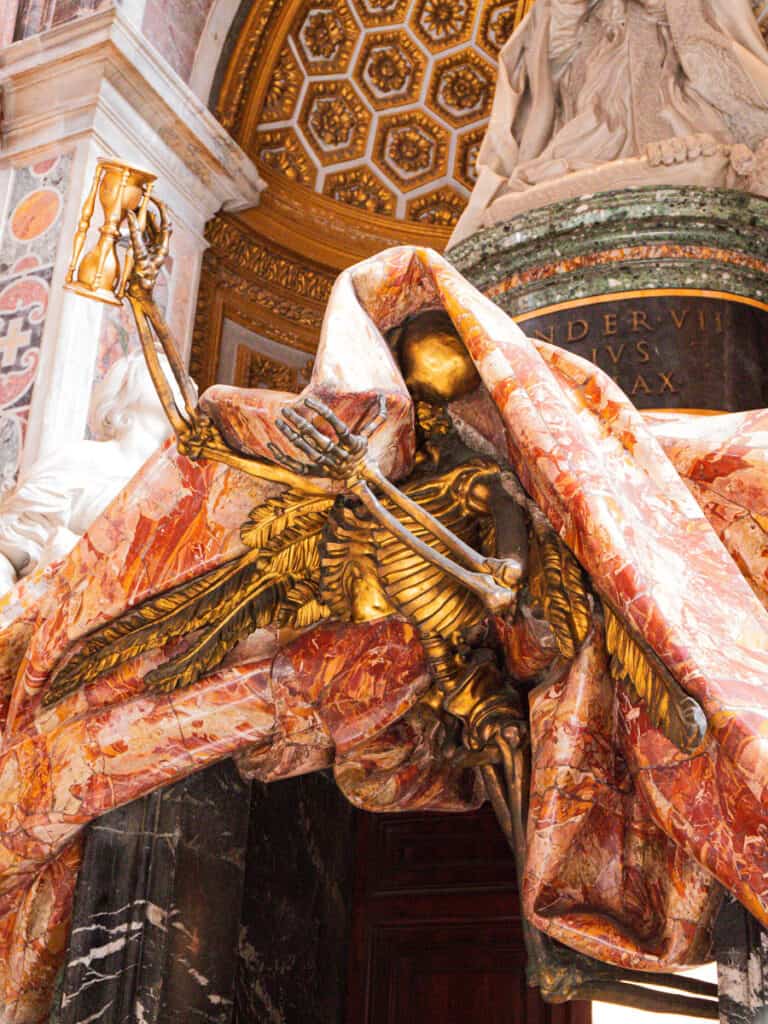
The copy of Raphael’s transfiguration. What I loved about this one was the interesting fact Kathy pointed out. This was not a painting but made up of miniature mosaic tiles. I never would have known this otherwise.
And that is why you can take photos in St Peter’s Basilica because all the paintings inside are actually mosaic!!
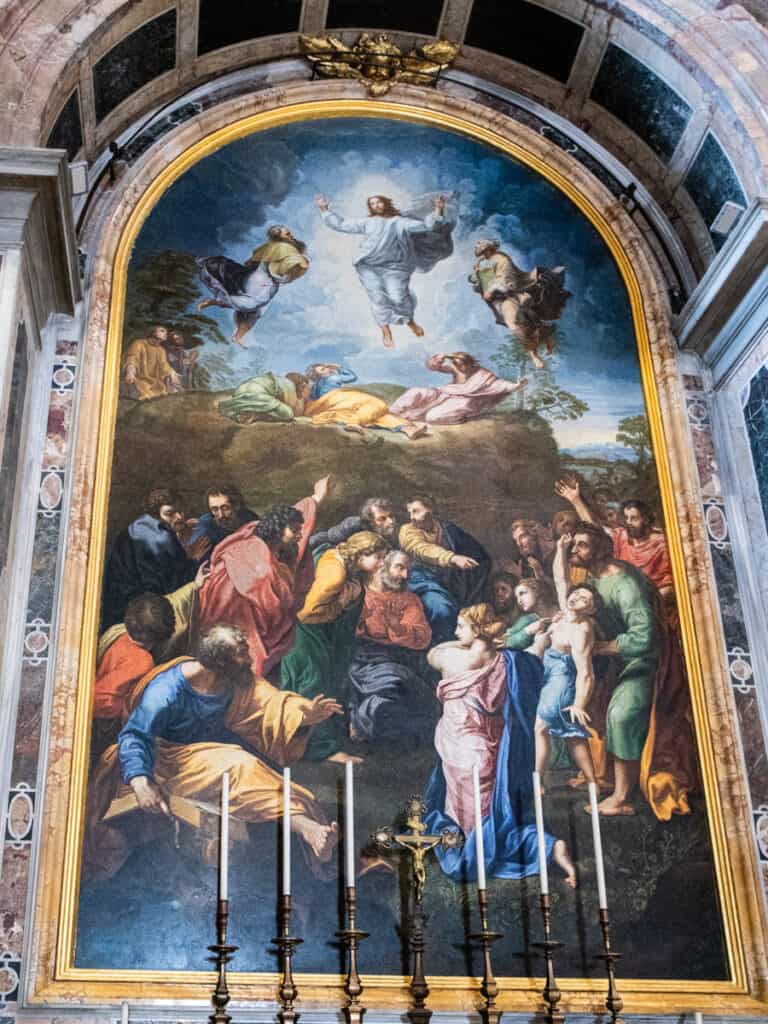
You can also explore the Vatican Grottoes, where the tombs of past popes lie, and marvel at the stunning Vatican Necropolis beneath the basilica.
Our tour ended inside the basilica, where we could have stayed to look around more. We were so Vatican tired at this point, we decided to skip touring the Vatican Grottoes.
Unfortunately, we booked our Liv tour too late to incorporate the dome climb. I’ve heard it’s one of the best things to do in Rome.
Saint Peter’s Square

The first landmark you see as you walk into The Vatican is Saint Peter’s Square, located in the heart of Vatican City.
This iconic square, designed by renowned architect Gian Lorenzo Bernini, is a magnificent showcase of Baroque artistry. The square was constructed between 1656 and 1667, serving as the grand entrance to St. Peter’s Basilica.
On these cobblestones, centuries of papal events, processions, and gatherings have taken place, including the Papal Audience, where the Pope offers his blessings.

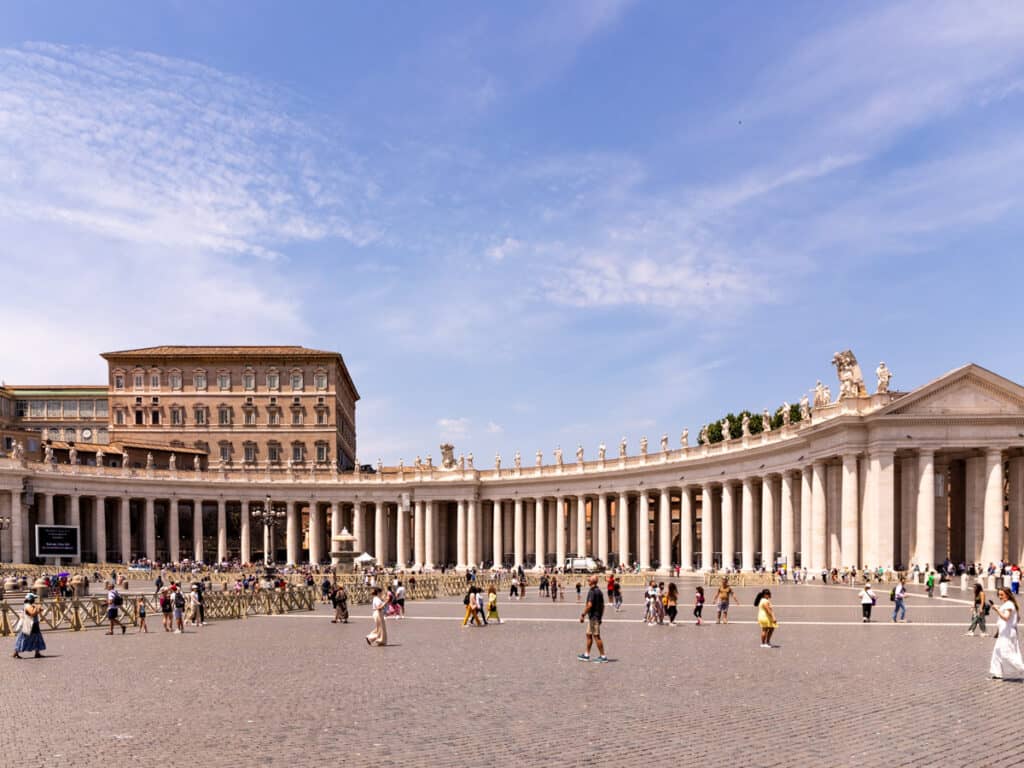
Encircled by two colonnades, which symbolize the embracing arms of the Church (and the borders of Vatican country), the square exudes a sense of unity and inclusion. At the center stands an ancient Egyptian obelisk, brought to Rome in 37 AD.
You can walk around here without a ticket.
Gardens of The Vatican City

The Gardens of Vatican City are a serene and enchanting oasis that offers a tranquil escape from the bustling streets of Rome.
Spanning an impressive 23 hectares, these gardens are a harmonious blend of natural beauty, architectural marvels, and spiritual significance.
With a rich history dating back to the Renaissance era, these gardens have evolved over the centuries into a masterpiece of art and horticulture.
They feature a meticulously designed layout adorned with sculptures, fountains, and monuments, some of which date as far back as the 9th century.
Stroll through the manicured lawns, meander along picturesque pathways, and discover hidden corners that offer breathtaking vistas of St. Peter’s Basilica and the surrounding Vatican City.
At present, the Gardens can only be visited by buying a ticket also including the Sistine Chapel.
This tour will take you through the Vatican gardens: Vatican Inside & Out: Sistine Chapel, Papal Train, & Summer Palace Lunch
Castel Sant’Angelo

Although technically outside The Vatican, The Castel Sant’Angelo is a worthy attraction worth checking out on your way to The Vatican.
This historic fortress holds a significant place in Rome’s rich history and was originally built as a mausoleum for Emperor Hadrian in the 2nd century AD.
It later served as a fortress and a papal residence. Today, it stands as a museum that offers visitors a glimpse into the city’s past and the Papacy.
NOTE: Castel Sant’Angelo is closed on Mondays! We missed out on seeing it because we did not know this! I really wanted to see the view from the rooftop here, which is meant to be magnificent. Get your skip the line tickets here.
How to Visit the Vatican Museum

The Vatican Museums are accessible from the main entrance on Viale Vaticano on the Northside of Vatican City.
There is a ticket office at this entrance where you can purchase your entrance ticket, but we highly recommend you book tickets online before you go as the queues are enormous and can see waiting times of up to 2 hours.
We also recommend booking a guided tour, as there is so much to see in the museums, you could spend days there and not see it all.
A guided tour takes you to the highlights of the museum and allows you to learn about the history and significance of artifacts from a knowledgeable guide.
Guided tours also allow you to enter the museum early before the general ticket office opens, allowing you to explore the museum without the crowds.
The museum is open Monday – Saturday from 9.00am to 6.00pm, with the final entry at 4.00pm. The museum is closed on Sundays, except for the last Sunday of the month where entry is free.
How to Visit Saint Peter’s Basilica

St Peter’s Basilica is another popular attraction in The Vatican and can be accessed from St Peter’s Square. You will know when you have found it when you see a huge line wrapping around the left side of the square.
It’s free to enter St Peter’s Basilica, however, you can purchase skip-the-line tickets online for guided tours before you visit to avoid standing in a queue. This is definitely worth it if you are short on time.
While it’s also free to enter the church, there are areas that require a ticket, namely the Vatican Treasury, The Necropolis, St Peter’s Tomb, and The Dome.
You can purchase tickets for these at the entrance upon entering the church, or by pre-purchasing tickets online before you go. You cannot purchase skip-the-line tickets from The Vatican, only online through third-party ticketing site that will be part of a guided tour.
How to Get to The Vatican

Getting to the Vatican is relatively easy since it’s located in the heart of Rome and can be accessed on foot. Rome is very walkable, so as long as you have comfortable shoes, you can easily walk there from anywhere within the city.
Depending on where you are in Rome, you may want to take the metro to The Vatican. You can use Line A of the Metro and alight at either Ottaviano or Cipro stations and walk for 5 minutes from there to The Vatican.
Alternatively, you can take bus number 81 bus from the Colosseum, which takes around 15 minutes.
It took us 15 minutes to walk along the Tiber River to our apartment rental in Trastevere.
In the summer long the riverfront are a line of small bars and restaurants. It was the perfect place for us to take advantage of Aperitivo hour with an Aperol Spritz (sodas for the girls) and snacks while we discussed what we learned at the Vatican and how we felt.
Tips for Visiting The Vatican

Before you go, be sure to follow these words of advice to ensure a smoother trip…
- Buy skip-the-line tickets for The Museums and St Stephen’s Basilica before you go to avoid spending two hours in a queue.
- Get a guided tour of the museums so you can be shown the highlights, otherwise, you will spend a very long time in there reading.
- Note that there is a dress code for The Vatican. Dress modestly and avoid wearing sleeveless shirts, low-cut tops, hats, shorts above the knee, mini skirts, or anything too revealing.
- You will need to cover your tattoos if you have any.
- Wear comfortable walking shoes as you will do a lot of walking here.
- Be prepared to go through security checks before entering the museums.
- There is a free cloakroom for large bags and suitcases.
- You cannot take any food or drink into the museums, so be sure to hydrate before going in.
- You cannot take photos inside The Sistine Chapel and you also cannot bring in any tripods, so leave those in the cloakroom.
FAQs About Visiting The Vatican

Can you just go into the Vatican?
Yes, there is no border control or passport screening, so you can just walk into The Vatican without a hitch. However, there is a police presence and security and they will ask you to leave if you are dressed immodestly.
Do you take your passport to the Vatican?
You do not need your passport to enter The Vatican.
Can I wear jeans to the Vatican?
You can wear jeans in The Vatican, as long as your knees are covered you will be fine.
What are the rules for visiting the Vatican?
You must abide by the dress code and you also cannot bring any knives, scissors, or sharp objects into the attractions such as the Basilica and Museums.
Final Thoughts
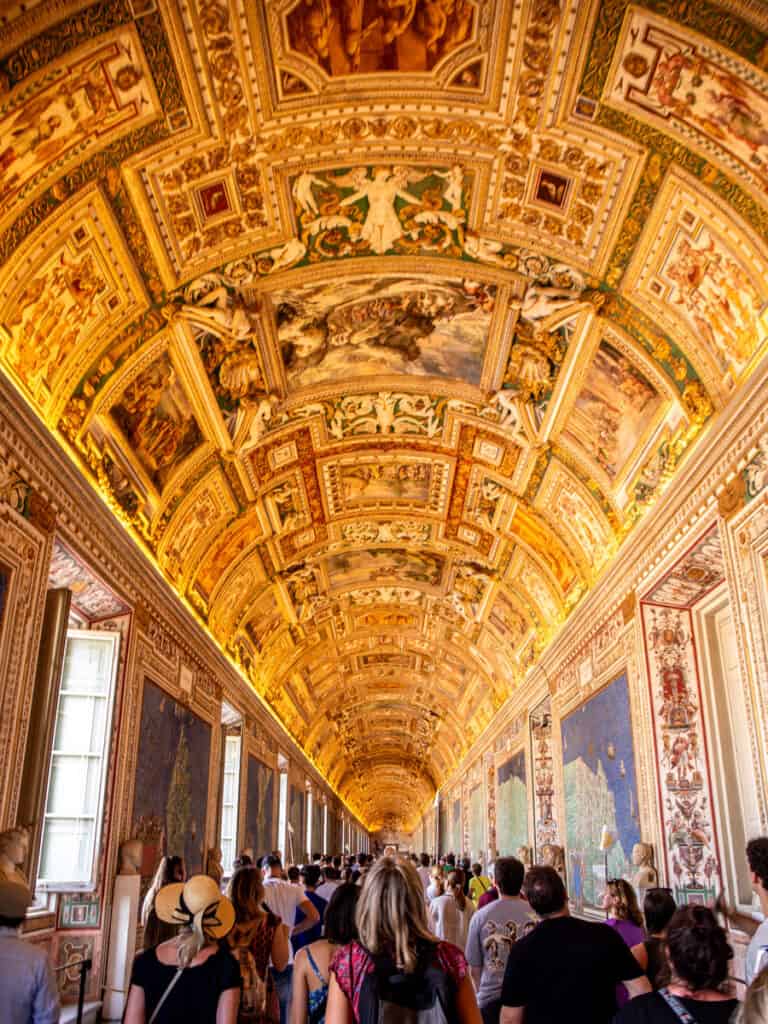
Vatican City is a destination with so much history, cultural treasures, and religious significance, that it would be a shame to visit Rome and not make the effort to go and see it.
It may be the smallest country in the world, but it has one of the world’s largest churches, some of the most famous works of Renaissance art, and an atmosphere of devotion and spiritual solace.
Don’t worry if you are not Catholic or even religious it’s worth visiting just for the historical and educational aspects of it. I was raised a Catholic, and even got my teaching degree at a Catholic University. But I left religion behind many years ago as I realized it was not the right way to experience God for me.

I thoroughly enjoyed the Vatican and it further emphasized for me that the decision I made was the right one. That’s why I love travel, and gift that to my daughters, it allows you to experience things for yourself and decide whether this is something you want to believe in or follow, rather than just following because it’s what family or society tells you to do.
While the Vatican is magnificent, I personally don’t feel Jesus would be comfortable with such opulence and power, and I don’t think that was his message or what he was about.
When our guide explained the church’s perspective on the opulence over again as “The house of God needs to magnificent,” the voice in my head said, “I think you’re missing the point.” His house – Mother Earth and the perfection of nature – is magnificent. His message was clear – love and kindness for ALL!!
Not build me extravagance dominated by male power. The overbearing masculinity of the Vatican made me feel cold and on edge. And why do churches always showcase death, fear, and destruction in their artistic representations.
Can we not show the JOY of God? That’s why my church is Mother Nature.
Our girls are not baptized and are free to choose whatever spiritual approach they Iike. I’m happy a visit to the Vatican helped them gain some insights into Catholicism and whether that is for them or not.
Apart from that, it’s a fantastic real-life art history experience that I did enjoy.
Whether you’re an art enthusiast, a history buff, or a seeker of spiritual experiences, we hope this guide to visiting the Vatican helped inspire your trip to this enchanting place.
More Tips for Rome
- FOOD TOURS: Unravel The History Of Roman Cuisine On A Rome Food Tour and The 7 Best Food Tours in Rome Italy In 2023
- ROME GUIDES: Your Guide To Rome with kids: Things To Do + Tips for Visiting AND 15 Memorable Things To Do In Rome (For 2023)
- EUROPE PLANNING: How to Plan a Trip to Europe with Kids: Essential Planning Tips and 17 Essential Tips For Visiting Europe With Kids
We have many more posts to come from our Italy summer trip. Join our email community so you don’t miss out! We have some free Europe Planning Guides for you.
Comment: Have you visited the Vatican? What did you think of it? Are you thinking of going? Let us know if you have any questions.


